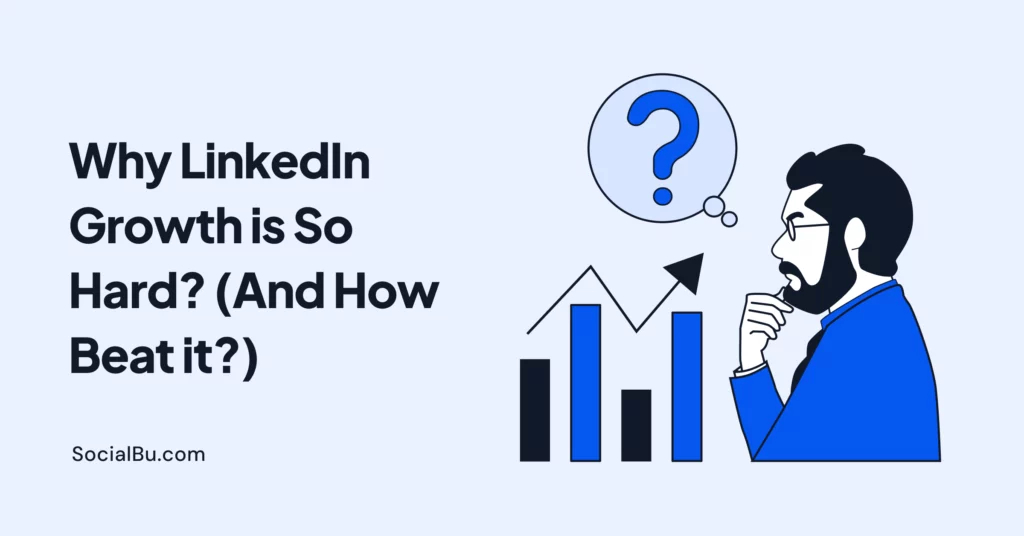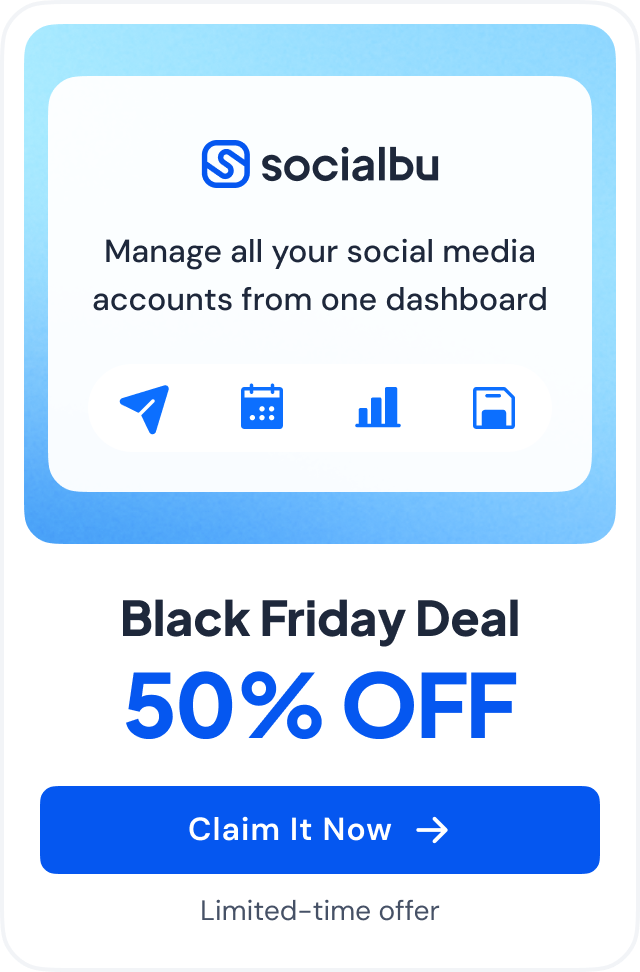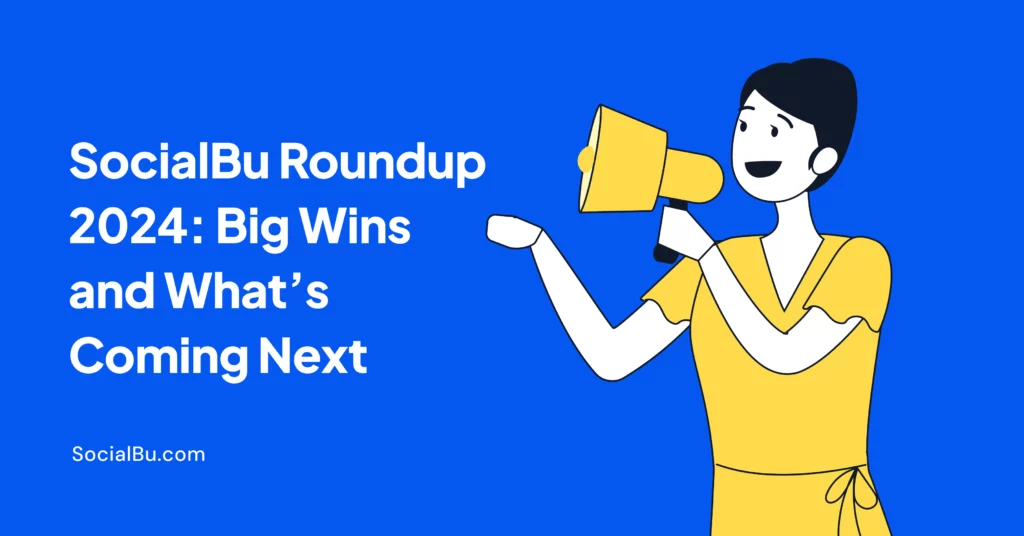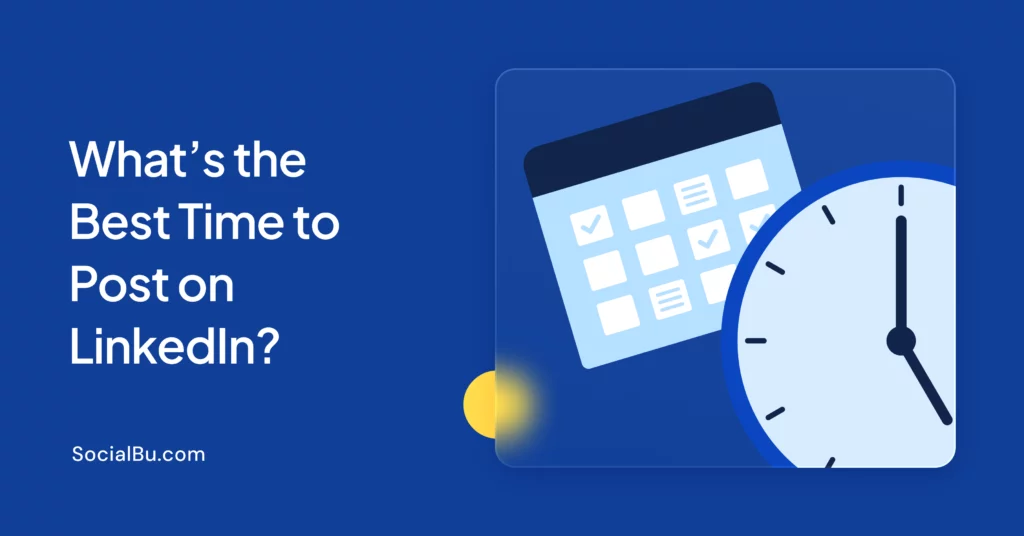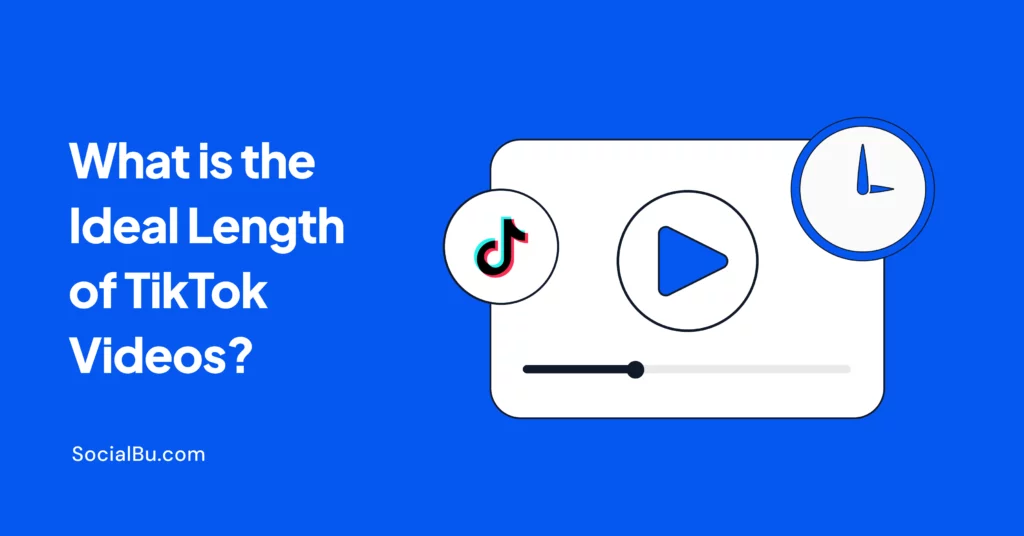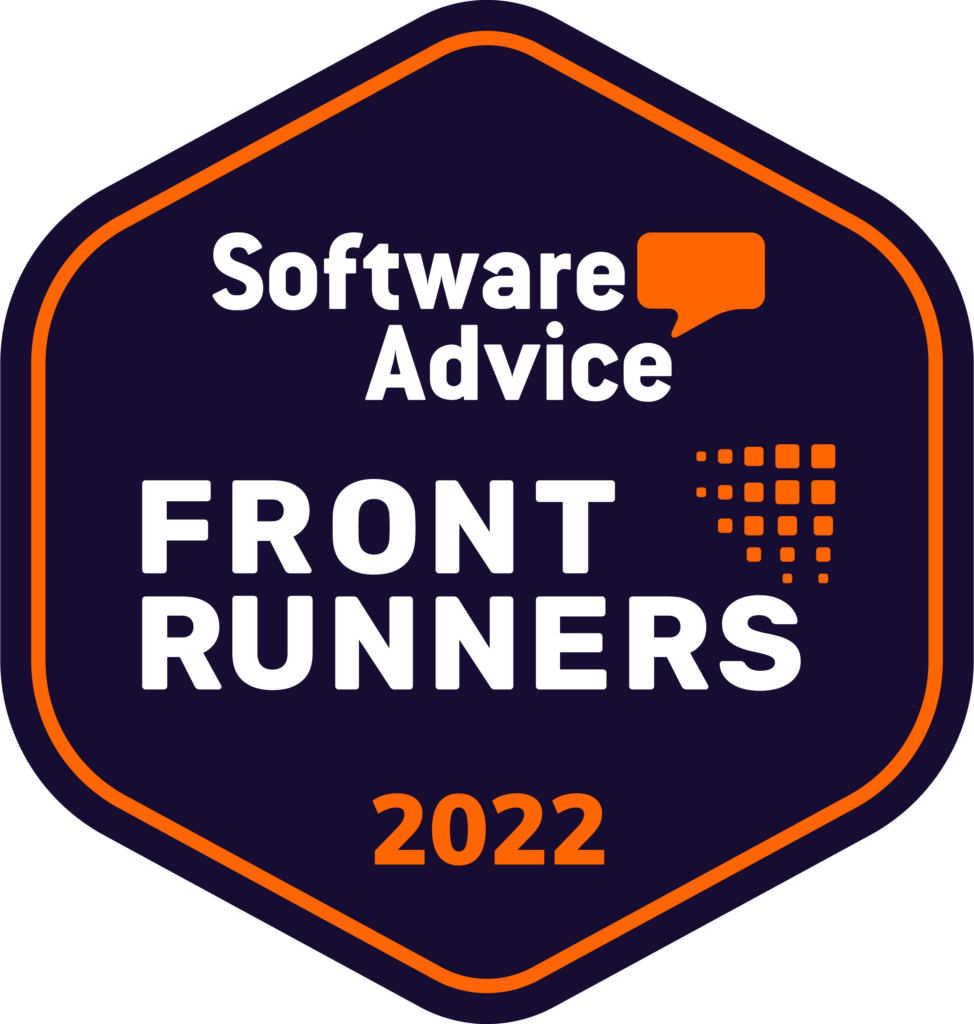LinkedIn growth in 2025 feels like slipping through quicksand. The algorithm favors thoughtful discussions over one-way mass postings that primarily target no audience or niche. It is causing most updates to be overlooked. To beat it, you need to adopt and master meaningful engagement, adapt your strategies with LinkedIn content optimization, and develop genuine B2B engagement.
Below, we discuss the real reasons why LinkedIn growth is so hard and why LinkedIn engagement is low, then share the exact steps you can take today to turn things around.
The LinkedIn Growth Potential in 2025
LinkedIn’s growth has opened up more opportunities than ever, even as the platform becomes increasingly competitive. Its growth stats are eye-opening:
- Massive user base: Over 1 billion members worldwide in 2025, up dramatically from years past.
- B2B lead engine: Approximately 80% of B2B leads generated on social media now originate on LinkedIn (more than any other platform).
- Content explosion: Users publish millions of posts, articles, and videos daily, swamping everyone’s feed.
- LinkedIn dominance: 84% of B2B marketers say LinkedIn gives them the best ROI versus other networks.
Despite these strengths, organic reach for company content has collapsed. Company pages now appear in only 1–2% of follower feeds. On LinkedIn, personal and employee posts reach about 40% of followers, while brand pages see only a few percent. To get noticed, companies need to adapt their approach or invest in ads.
Ready to get noticed? Sign up for SocialBu’s LinkedIn automation tools and strengthen your presence.
Why LinkedIn Growth is So Hard in 2025
- LinkedIn’s algorithm now prioritizes “meaningful engagement” over broad reach.
- The algorithm shows your content only if people interact with it quickly and deeply.
- Posts that receive positive reactions or comments within the first hour are promoted further.
- Any hint of “spammy” behavior or lackluster interest and reach is cut.
Content Saturation
- Content saturation is at an all-time high: a LinkedIn feed in 2025 can have almost three times as many posts per connection as in 2022.
- Every scroll becomes a competitive battle with more colleagues, creators, and brands vying for attention.
- Attention spans have shrunk as users are bombarded with information.
The result is that organic reach has plummeted (one report finds creator engagement and follower growth have dropped 50% YoY).
In short, LinkedIn growth is hard because the bar is higher. The platform won’t deliver views unless your content truly connects with a professional audience.
The Biggest Challenges of Growing on LinkedIn in 2025
You may have noticed a decline in LinkedIn engagement in 2025. For example, even top creators with tens of thousands of followers are reporting a sharp drop in post views and interactions.
- @Leslie Hughes shared that reach is down roughly 50% for most creators, and engagement and follower growth have declined for 95% of users. Yet even as a LinkedIn Top Voice, she’s seen her metrics drop significantly.
- @Chris Donnelly reported that LinkedIn’s organic reach is down by over 25% year-over-year, median impressions are off by 13% since Q4 2024, and even the top 5% of posts are seeing a 30% drop in impressions.
So, what’s behind this widespread drop in reach and engagement? Let’s break down the main reasons.
Overcrowded Feeds and Fatigue
- With so much content posted every day, even your strongest post may only reach a tiny fraction of your followers.
- As we already mentioned, only 1–2% of your network sees a given post. Many users report receiving only a few dozen views per post, despite having hundreds of followers.
Strict Spam/Automation Detection
- LinkedIn’s filters are stricter now. Mass connection requests, repetitive outreach messages, or engagement pods are flagged as spam.
- Profiles that use generic “Hi, let’s connect” invites or post duplicate content repeatedly can see that their acceptance rates and reach have declined.
- For context, a well-targeted personalized invitation campaign today might yield an acceptance rate of 40–50%, significantly lower than in earlier years.
Algorithmic Clampdown
- LinkedIn now intentionally suppresses overly promotional or low-value content. Posts with external links lose 25-35% reach, and keyword-stuffed or off-topic content is deprioritized.
- The latest updates even penalize broad hashtags and link previews.
- In short, anything resembling spam or clickbait (e.g., “check out my promo link”) is downranked.
Together, these factors mean your posts get a fraction of the visibility they used to. One marketing study warns that average post reach has dropped over 28% year-over-year, especially for company pages.
The solution to this is creating authentic, high-value content that sparks genuine dialogue and avoiding outdated tactics that no longer work. This is why LinkedIn engagement is low across the board.
The Impact of Algorithm Changes on LinkedIn Growth
LinkedIn’s 2024-25 algorithm changes have a clear theme: reward conversations, not broadcasting. The platform now evaluates posts in stages:
- Filter for basic quality (no spam)
- Test with a small audience
- Expand if there’s real engagement
Comments are now analyzed more deeply:
- A comment longer than a sentence is twice as effective as a like at boosting reach.
- Adding a few thoughtful comments within the first hour can resurface your post to all participants, often resulting in 25% more views.
These changes mean prioritizing community interaction is no longer optional.
- Simply broadcasting news or link‑dropping won’t catch the algorithm’s eye.
- LinkedIn’s algorithm in 2025 now prioritizes ads and sponsored content over organic creator posts. Paid promotions dominate user feeds, significantly reducing the visibility and reach of unpaid posts.
- Instead, posts that spark discussion, such as questions, opinionated takes, or polls, tend to perform better.
- Longer, thoughtful comments of over 10 words can double your post’s reach, and comments over 15 words can boost it by about 2.5× compared to short remarks.
- Early engagement (likes, shares, comments) within the first one to two hours signals value to LinkedIn’s algorithm, significantly increasing the likelihood of broader distribution.
Profile Visibility Tactics That No Longer Work
Many old-school tricks are now dead on LinkedIn. For example:
Mass Invites and Engagement Pods
- Bombarding hundreds of people with default connection invites or coordinating in “pods” to exchange likes/comments are being ruthlessly filtered out.
- People are simply not accepting random invites.
- Industry data shows targeted, relevant invites yield only 40–50% acceptance rates now.
- Spammy tactics hurt your credibility.
Therefore, focus on quality now. Only reach out to those who know you or share interests, and constantly personalize the message.
Generic Content Formats
- Infographics laden with buzzwords, stock-photo posts, or long, unrelated text no longer capture attention.
- The old hack of posting any content daily to “game” the system is ineffective; LinkedIn now checks the content.
- Posts that come across as repetitive or soulless tend to have negligible reach. Instead, you should focus on providing unique insights and authenticity.
Ignored Profiles
- If your profile is unfinished or outdated, your content suffers.
- A strong LinkedIn presence depends on completeness and branding (profile pic, headline, rich media).
- Strategies like keyword stuffing your headline or overloading on buzzwords have lost their charm.
- Instead, modern profile visibility tactics mean using relevant 2025 keywords (e.g., “AI strategy”, “sustainable tech”, etc.) and showcasing recent work.
In short, shortcuts are gone. To grow now, you must invest in genuine relationship-building and stand-out content. Connection growth today comes from genuine networking, not spray-and-pray invitations.
What Content Works Best on LinkedIn in 2025?
Despite the challenges, specific content formats consistently outperform on LinkedIn’s new algorithm. These are mentioned below:
Personal Experiences and Storytelling
- @Daivik Goel stated that “Personal storytelling on LinkedIn isn’t just content. It’s your growth engine,” sharing how narrating the critical milestones of his startup journey, including challenges, small wins, and failures, in public posts built genuine connections, trust, and community, driving meaningful engagement and real business opportunities.
Short-Form Video
- LinkedIn has bet heavily on video. Short vertical clips (30–90 seconds) are the fastest-growing category on the platform.
- LinkedIn reports a 36% year-over-year increase in video viewership in late 2024. Video attracts quick engagement (reactions, shares) and is favored by the feed algorithm.
- LinkedIn itself has advised using subtitles and hooking viewers within the first 3 seconds.
Carousel Posts (Document/PDF)
- Swipeable carousels are still a success.
- An analysis of 1M LinkedIn posts found that carousel-style documents (PDF slides) earn the highest engagement of any format.
- In that study, carousels got more interactions than videos or static images.
- LinkedIn users love slide decks that tell a data-driven story or case study, making them ideal for thought leadership or tutorials.
Thought Leadership Text/Image Posts
- Posts that share genuine expertise or insights (often with a personal twist) still resonate.
- Long text posts that begin with an engaging hook, share data or a lesson, and end with a question tend to generate comments.
- While videos reach more eyes, text and image posts tend to spark more conversation per viewer.
- Use high-quality images or graphs to illustrate key points.
Polls and Interactive Posts
- Quick polls and “choose your opinion” posts get picked up for impressions (even if not the most likes).
- LinkedIn’s analysis shows polls drive high visibility and are prioritized in feeds. Use them to involve your network (e.g., “What’s your #1 2025 marketing focus?”).
Data-Driven and Case Studies
- Content with precise data or results (charts, metrics, case story bullets) stands out in a professional feed.
- If you can demonstrate ROI, growth numbers, or industry stats unique to your experience, audiences take notice.
- Case studies about your customers or projects are especially shareable, as they provide concrete proof of expertise.
All in all, apply LinkedIn content optimization by uploading native media (video, PDF, etc.) rather than linking externally, and focus on formats LinkedIn rewards.
Use SocialBu’s content scheduling and analytics to test and optimize your LinkedIn posts for maximum engagement. Also read the “Top 11 Tools to Write LinkedIn Posts With AI for Personal Branding.”
How to Beat LinkedIn Growth Hurdles in 2025
Given the scrutiny of the LinkedIn algorithm above, how can you effectively counter it and grow? Here are the top strategies for 2025.
Improve LinkedIn Growth Metrics with Data-Driven Tactics
Quality over Quantity
- Post 3–4 high‑value updates per week instead of daily fluff
- Follow a “3‑2‑1” rhythm (3 key posts, 2 curated, 1 personal/promo) to boost reach by 204%
- Aim for a few well‑researched LinkedIn posts weekly, not 7 low‑effort updates
Leverage New LinkedIn Features
- Publish Newsletters for broader distribution and subscriber flags
- Host Audio Events and LinkedIn Live streams to reach new audiences
- Contribute to Collaborative Articles to appear in multiple feeds
Actionable Planning
- Review post impressions, clicks, and comments weekly to spot winning formats
- Identify top performers (e.g., carousels vs. images, best posting times)
Track your LinkedIn growth metrics in real time with SocialBu’s advanced analytics dashboard. These data-driven tweaks show you how to grow your LinkedIn following more effectively.
Profile Optimization for Maximum Visibility
Your profile is your personal brand on LinkedIn; optimize it to grab attention:
Strategic Headline and About
- Update your headline and summary with 2025-relevant keywords (e.g., your specialty plus “AI”, “remote work expert”, etc.).
- Use clear language about how you help others. Profiles with target keywords see exponentially more views.
Visual Media
- Add rich visual media (PDFs, slide decks, videos) to your profile’s Featured section.
- Show off case studies, talks, or notable projects.
- Profiles with portfolios or multimedia appear more in searches and are more engaging.
Complete Everything
- Ensure your Experience section is detailed and up-to-date.
- LinkedIn data shows that completed profiles are dozens of times more likely to get found by recruiters or clients.
- Add skills endorsements and any relevant certifications.
- A polished profile also signals credibility, which boosts engagement on your posts (people trust and interact more with “verified” experts).
Build Authentic Engagement and Community
Personalized Engagement
- Instead of generic comments, reply thoughtfully on others’ posts and mention them by name.
- This both nurtures real relationships and works well with the algorithm.
- Writing one helpful comment on another’s post can increase your profile views and connections.
- Resist automation here; genuine tone wins.
Niche Collaborations
- Partner with industry peers or micro‑influencers for joint content (e.g., interviews, LinkedIn Lives, co‑authored posts).
- When you tag each other, you also tap into their audience.
- Community group posts (e.g., posts in interest‑based LinkedIn Groups) can spotlight you to a focused network.
Early Engagement
- Prompt your close network to engage immediately.
- Tell a colleague or friend to comment soon after you post, or pin a comment from yourself.
- Remember, posts with 5+ early comments are far more likely to “go viral” under LinkedIn’s rules.
- Start by asking a provocative question in the first comment and reply to it quickly, jumpstarting that engagement loop.
Offer Value
- Host regular Q&A sessions or mini‑webinars via LinkedIn Live.
- People are more likely to follow and engage when they feel part of an active community, not just passive connections.
For example, weekly “Ask Me Anything” posts or polls about industry challenges can keep your network involved.
- Each interaction increases your profile’s visibility to others over time.
These tactics enhance B2B engagement and demonstrate how to cultivate a LinkedIn following by fostering genuine connections and adding value.
Are LinkedIn Ads Worth It in 2025?
- Paid ads convert well for B2B goals, yielding 2.5× higher conversion rates than other social platforms.
- Professional targeting by job title, company size, and industry delivers highly qualified leads.
- If budget allows, use Sponsored Content or InMail to reach people who don’t yet follow you.
- Don’t abandon organic tricks. Boost top posts strategically for big announcements.
- Always measure ROI (Cost per Lead, pipeline generated).
Conclusion
LinkedIn in 2025 is double-faced. It is a booming professional networking hub with unparalleled lead potential, but a challenging landscape for organic LinkedIn growth. Your answer to overcome this is to adapt to changes.
Focus on creating valuable, engaging content (especially video and carousels), use LinkedIn’s latest features (newsletters, live events), and build genuine connections. Avoid spammy tactics and instead, join the conversation early, allowing the algorithm to reward your meaningful engagement.
With patience and smart tools like SocialBu, you can beat the odds and grow your LinkedIn presence even in 2025’s tough environment.
FAQs
Can LinkedIn Ads boost growth this year?
Yes, LinkedIn Ads are increasingly effective for B2B marketing. Performance data shows LinkedIn ads now deliver up to 2.74% visitor‑to‑lead conversion, significantly outperforming other channels.
How often should I post on LinkedIn?
Post 3–5 times weekly, ideally on weekdays mid‑morning, to maximize engagement without overwhelming your audience.
Are connection invites still effective?
Yes, connection invites remain effective. Targeted outreach scores a steady 40–50% acceptance rate today.
